#Hydrogen propulsion
Explore tagged Tumblr posts
Text







Piasecki PA-890
#art#design#flying private#travels#luxury lifestyle#flying palace#jetsetter#jetset#helicopter#piasecki#hydrogen propulsion#piasecki PA-890#billionaire#billionairelife#helicopter concept#concept
16 notes
·
View notes
Text
Hydrogen Rockets: The Key to Sustainable Space Exploration
Introduction to Hydrogen Rocket Engine
In the realm of space exploration, the quest for efficient propulsion systems has led to the development and utilization of hydrogen rocket engines. These engines harness the power of hydrogen, the most abundant element in the universe, to propel spacecraft into the cosmos with remarkable efficiency and power.
History of Hydrogen Rocket Engine Development
The concept of using hydrogen as a propellant dates back to the early days of rocketry. However, it wasn't until the mid-20th century that significant advancements were made in the development of hydrogen rocket engines. Pioneering work by scientists and engineers paved the way for the modern hydrogen propulsion systems we see today.
How Hydrogen Rocket Engines Work
Fuel Combustion Process
Hydrogen rocket engines operate on the principle of combustion. Liquid hydrogen is combined with liquid oxygen in a combustion chamber, where it undergoes a controlled explosion. This rapid combustion generates intense heat and pressure, producing a powerful stream of hot gases.
Thrust Generation
The expulsion of these hot gases through a nozzle at the rear of the rocket creates thrust according to Newton's third law of motion. This thrust propels the rocket forward, overcoming the forces of gravity and atmospheric resistance.
Advantages of Hydrogen Rocket Engines
Hydrogen rocket engines offer several key advantages over conventional propulsion systems:
High Efficiency: Hydrogen boasts one of the highest specific impulse values among rocket propellants, making it extremely efficient in terms of thrust per unit of propellant mass.
Clean Combustion: The combustion of hydrogen with oxygen produces water vapor as a byproduct, resulting in cleaner emissions compared to traditional rocket fuels.
Abundant Resource: Hydrogen is abundant in the universe, making it a sustainable and readily available resource for space exploration endeavors.
Challenges and Limitations
Despite its many advantages, hydrogen rocket technology also faces significant challenges and limitations.
Cryogenic Storage
One of the primary challenges associated with hydrogen rocket engines is the need for cryogenic storage. Liquid hydrogen must be kept at extremely low temperatures to remain in a liquid state, requiring specialized storage and handling systems.
Cost and Infrastructure
The infrastructure required to produce, store, and transport liquid hydrogen adds to the overall cost of hydrogen rocket technology. Additionally, the development of hydrogen propulsion systems necessitates substantial investments in research and development.
Applications of Hydrogen Rocket Engines
Hydrogen rocket engines find a wide range of applications in space exploration and satellite deployment missions.
Space Exploration
Hydrogen-powered rockets enable spacecraft to travel vast distances across the solar system, facilitating missions to explore distant planets, moons, and celestial bodies.
Satellite Deployment
The high efficiency and reliability of hydrogen rocket engines make them ideal for launching satellites into orbit around the Earth and beyond.
Comparison with Traditional Rocket Engines
Compared to traditional rocket engines fueled by kerosene or solid propellants, hydrogen rocket engines offer superior performance and environmental benefits. They deliver higher specific impulse and produce cleaner emissions, contributing to a more sustainable approach to space exploration.
Environmental Impact and Sustainability
The environmental impact of hydrogen rocket engines is relatively minimal compared to conventional propulsion systems. The use of hydrogen as a fuel results in cleaner combustion and reduced greenhouse gas emissions, aligning with efforts to mitigate the environmental footprint of space exploration activities.
Future Prospects and Developments
As technology advances and our understanding of hydrogen propulsion deepens, the future holds great promise for hydrogen rocket engines. Ongoing research and development efforts aim to enhance efficiency, reduce costs, and overcome existing limitations, paving the way for new frontiers in space exploration.
Conclusion
Hydrogen rocket engines represent a cornerstone of modern space exploration, offering unparalleled efficiency, reliability, and environmental sustainability. While challenges remain, ongoing advancements in technology and infrastructure continue to expand the horizons of human spaceflight and scientific discovery.
FAQs
Are hydrogen rocket engines more powerful than traditional rocket engines? Hydrogen rocket engines typically offer higher specific impulse values, making them more efficient in terms of thrust per unit of propellant mass.
What are the main challenges associated with hydrogen rocket technology? Cryogenic storage and infrastructure costs are among the primary challenges facing hydrogen rocket technology.
What are the environmental benefits of hydrogen rocket engines? Hydrogen combustion produces cleaner emissions compared to traditional rocket fuels, contributing to reduced environmental impact.
What are the primary applications of hydrogen rocket engines? Hydrogen rocket engines are used in space exploration missions and satellite deployment operations.
What does the future hold for hydrogen rocket technology? Ongoing research and development efforts aim to improve efficiency, reduce costs, and expand the capabilities of hydrogen rocket engines.
#Hydrogen propulsion#Rocket engine technology#Space exploration#Liquid hydrogen#Rocket propulsion systems#Sustainable propulsion#Cryogenic storage#Spacecraft propulsion#Rocket engine efficiency#Environmental sustainability
0 notes
Text
KG Mobility dezvoltă un motor termic alimentat cu hidrogen: Autonomie de peste 500 km
KG Mobility, cunoscut anterior ca SsangYong, a anunțat că va dezvolta motoare alimentate cu hidrogen. Constructorul sud-coreean își propune să producă un motor care să ofere o autonomie mai mare de 500 de kilometri. Parteneriat pentru dezvoltarea unui motor cu hidrogen KG Mobility urmează să înceapă în curând dezvoltarea primului său motor alimentat cu hidrogen. Marca asiatică este implicată în…

View On WordPress
#500 km range#alternative fuel#alternative propulsion#alternative vehicles#aplicații industriale#aprindere prin compresie#automotive industry#automotive innovation#automotive technology#autonomie 500 km#Autonomie Vehicule#bam#combustibil alternativ#compression ignition#control units#Coreea de Sud#diagnoza#direct injection#eco-friendly cars#emisii reduse#energie regenerabilă#future of cars#green transport#hidrogen auto#hydrogen car#hydrogen combustion engine#hydrogen engine#hydrogen injection#hydrogen technology#hydrogen vehicles
0 notes
Text
#hydrogen yacht#eco friendly#luxury yacht#sunreefyachts#sustainable#yacht#design#green propulsion#eco yacht
0 notes
Text

Spinoffs: Space Station Innovations in Your Cart (and Heart!)
You might think NASA technology is just spaceships and telescopes, but did you know the camera in your cell phone is, too? It’s one of many NASA innovations now found everywhere on Earth.
The International Space Station has had crew living on it for 25 years straight. In that time, the space station has enabled a tremendous amount of research, helping NASA and scientists better understand long-term living in space – but it’s not just knowledge coming back down to Earth! Technologies developed for the space station and experiments conducted aboard the orbiting lab also benefit people on the planet below. Here are a few of these inventions, or spinoffs, you can find in your everyday life.

A Sunscreen That Blocks Radiation in Space – and on Your Face
After surviving for 18 months outside the International Space Station, an extremely hardy organism is now improving sunscreens and face cream products from a cosmetics company, which licensed use of the organism from NASA’s Jet Propulsion Laboratory.
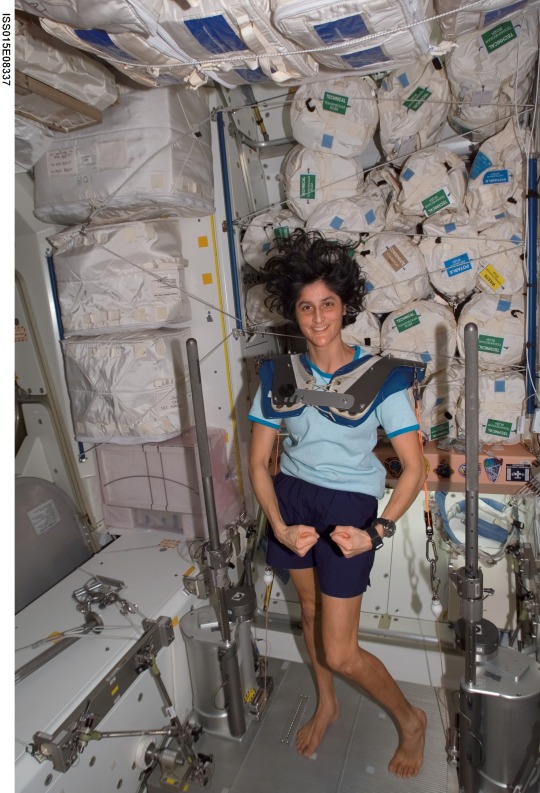

Build Muscle With or Without Gravity
Muscles atrophy quickly in space, so when astronauts began long stays on the International Space Station, they needed some specialized exercise equipment. A resistance mechanism made of a coiled metal spring formed the basis of the first way for astronauts to “lift weights” in space. Soon after, that same design became the heart of compact home gym equipment.

Fresh Greens Every Day of the Year
The need to grow fresh food in space pushed NASA to develop indoor agriculture techniques. Thanks to the agency’s research, private companies are building on NASA’s vertical farm structure, plant-growth “recipes,” and environmental-control data to create indoor farms, resulting in higher crop yields and better-quality produce while conserving water and energy and eliminating the need for pesticides.
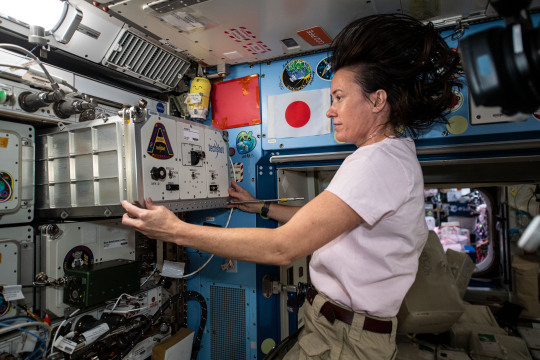
Cultivating Hearts and Knees in Space
Gravity is a significant obstacle to bioprinting cells and growing human tissue on Earth because heavier components settle to the bottoms of petri dishes. In the absence of gravity, each cell layer stays in place, which is how it’s possible to grow heart and knee tissue on the space station. The same principle also allows mixing of complex pharmaceuticals on orbit.

Storing Oodles of Energy
NASA chose nickel-hydrogen batteries to power the Hubble Space Telescope and the International Space Station because the technology is safe, reliable in extreme temperatures, and long-lived. NASA’s improvements brought down the cost of the technology, which is now used by large-scale utilities and renewable power plants that need to store energy generated by intermittent sources.
You can read about many more products sourced from the ISS on spinoff.nasa.gov.
Make sure to follow us on Tumblr for your regular dose of space!
2K notes
·
View notes
Text
Hydrogen Fuel Cells for Boat Market Analytical Overview and Growth Opportunities by 2032
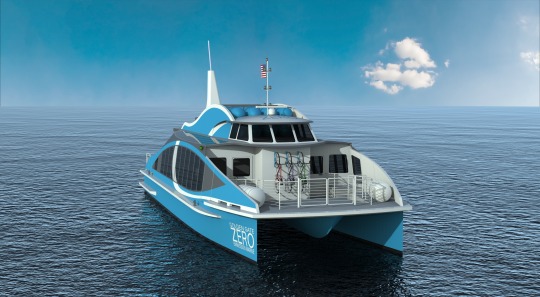
The hydrogen fuel cells for the boat market is experiencing significant growth due to the increasing demand for clean and sustainable energy solutions in the marine industry.Hydrogen fuel cells offer a viable alternative to conventional fossil fuel-powered engines, as they produce zero-emission and have higher energy efficiency.
Government regulations and initiatives promoting the use of eco-friendly technologies in the maritime sector are driving the adoption of hydrogen fuel cells for boats.The market is witnessing the development of advanced hydrogen fuel cell technologies, including improved storage and refueling infrastructure, which is further boosting market growth.
The increasing focus on reducing carbon emissions and achieving environmental sustainability goals by boat manufacturers and operators is propelling the demand for hydrogen fuel cells.suppliers, are crucial for the widespread adoption and commercialization of hydrogen fuel cells for boats.
Analytical Overview:
The hydrogen fuel cells for boat market is projected to experience substantial growth in the coming years, driven by the increasing demand for clean energy solutions in the maritime industry.
Market players are focusing on research and development activities to enhance the performance and efficiency of hydrogen fuel cell technologies specifically tailored for marine applications.
Government regulations and initiatives promoting sustainable shipping practices are expected to create a favorable market environment for hydrogen fuel cells.
The market is witnessing the emergence of new players and strategic partnerships, leading to technological advancements and the expansion of product portfolios.
Geographically, North America and Europe are anticipated to be the key regions for hydrogen fuel cells in boats, owing to the presence of established boat manufacturers and supportive government policies promoting renewable energy adoption. However, the Asia Pacific region is also expected to witness significant growth due to the growing maritime industry and increasing environmental concerns.
Segments:
Power Output: The market can be segmented based on power output capacity, ranging from low-power fuel cells suitable for auxiliary power to high-power systems for primary propulsion.
Boat Type: Segmentation can be done based on boat types, such as leisure boats, commercial vessels, ferries, and yachts, as the adoption of hydrogen fuel cells varies across these segments.
End Use: Another segmentation criterion is the end-use application, including passenger transportation, cargo shipping, naval vessels, and recreational boating.
Geography: The market can be segmented based on geographic regions, such as North America, Europe, Asia Pacific, and Rest of the World, as the adoption and growth potential vary across different regions.
Component: Segmentation based on components includes fuel cell stacks, hydrogen storage tanks, power electronics, and balance of plant (BOP) systems, which are essential for the overall functioning of hydrogen fuel cells.
Growth Opportunities:
Increasing Investments: Growing investments in research and development activities for hydrogen fuel cell technologies for boats present significant growth opportunities in the market.
Infrastructure Development: Expansion of hydrogen refueling infrastructure and charging networks for boats would encourage the adoption of hydrogen fuel cells in the maritime sector.
Collaborations and Partnerships: Collaborations between boat manufacturers, fuel cell suppliers, and infrastructure providers can drive innovation and accelerate the market growth.
Government Support: Continued support from governments through subsidies, incentives, and policy frameworks promoting the adoption of hydrogen fuel cells in the marine industry can fuel market growth.
Technological Advancements: Advancements in hydrogen fuel cell technologies, such as enhanced power density, improved durability, and cost reduction, will open up new growth opportunities for market players.
Key Points:
Hydrogen fuel cells offer longer operational ranges and faster refueling times compared to battery-powered systems, making them suitable for extended boating trips and commercial applications.
The transition towards hydrogen fuel cells aligns with the global maritime industry's efforts to decarbonize and reduce greenhouse gas emissions.
The adoption of hydrogen fuel cells in the boat market can significantly contribute to achieving international sustainability goals and addressing climate change concerns.
Challenges such as the high initial cost of hydrogen fuel cell systems and limited hydrogen refueling infrastructure need to be addressed to accelerate market growth.
Collaborative efforts among stakeholders, including boat manufacturers, governments, and fuel cell
We recommend referring our Stringent datalytics firm, industry publications, and websites that specialize in providing market reports. These sources often offer comprehensive analysis, market trends, growth forecasts, competitive landscape, and other valuable insights into this market.
By visiting our website or contacting us directly, you can explore the availability of specific reports related to this market. These reports often require a purchase or subscription, but we provide comprehensive and in-depth information that can be valuable for businesses, investors, and individuals interested in this market.
“Remember to look for recent reports to ensure you have the most current and relevant information.”
Click Here, To Get Free Sample Report: https://stringentdatalytics.com/sample-request/hydrogen-fuel-cells-for-boat-market/6003/
Market Segmentations:
Global Hydrogen Fuel Cells for Boat Market: By Company • Dynad International • PowerCell Sweden • Serenergy • Toshiba • Fiskerstrand Verft • MEYER WERFT • Nuvera Fuel Cells • WATT Fuel Cell Global Hydrogen Fuel Cells for Boat Market: By Type • Polymer Electrolyte Membrane Fuel Cell (PEMFC) • Solid Oxide Fuel Cell (SOFC) Global Hydrogen Fuel Cells for Boat Market: By Application • Yatchs • Sailboats • Others Global Hydrogen Fuel Cells for Boat Market: Regional Analysis All the regional segmentation has been studied based on recent and future trends, and the market is forecasted throughout the prediction period. The countries covered in the regional analysis of the Global Hydrogen Fuel Cells for Boat market report are U.S., Canada, and Mexico in North America, Germany, France, U.K., Russia, Italy, Spain, Turkey, Netherlands, Switzerland, Belgium, and Rest of Europe in Europe, Singapore, Malaysia, Australia, Thailand, Indonesia, Philippines, China, Japan, India, South Korea, Rest of Asia-Pacific (APAC) in the Asia-Pacific (APAC), Saudi Arabia, U.A.E, South Africa, Egypt, Israel, Rest of Middle East and Africa (MEA) as a part of Middle East and Africa (MEA), and Argentina, Brazil, and Rest of South America as part of South America.
Visit Report Page for More Details: https://stringentdatalytics.com/reports/hydrogen-fuel-cells-for-boat-market/6003/
Reasons to Purchase Hydrogen Fuel Cells for Boat Market Report:
• To obtain insights into industry trends and dynamics, including market size, growth rates, and important factors and difficulties. This study offers insightful information on these topics.
• To identify important participants and rivals: This research studies can assist companies in identifying key participants and rivals in their sector, along with their market share, business plans, and strengths and weaknesses.
• To comprehend consumer behaviour: these research studies can offer insightful information about customer behaviour, including preferences, spending patterns, and demographics.
• To assess market opportunities: These research studies can aid companies in assessing market chances, such as prospective new goods or services, fresh markets, and new trends.
• To make well-informed business decisions: These research reports give companies data-driven insights that they may use to plan their strategy, develop new products, and devise marketing and advertising plans.
In general, market research studies offer companies and organisations useful data that can aid in making decisions and maintaining competitiveness in their industry. They can offer a strong basis for decision-making, strategy formulation, and company planning.
About US:
Stringent Datalytics offers both custom and syndicated market research reports. Custom market research reports are tailored to a specific client's needs and requirements. These reports provide unique insights into a particular industry or market segment and can help businesses make informed decisions about their strategies and operations.
Syndicated market research reports, on the other hand, are pre-existing reports that are available for purchase by multiple clients. These reports are often produced on a regular basis, such as annually or quarterly, and cover a broad range of industries and market segments. Syndicated reports provide clients with insights into industry trends, market sizes, and competitive landscapes. By offering both custom and syndicated reports, Stringent Datalytics can provide clients with a range of market research solutions that can be customized to their specific needs
Contact US:
Stringent Datalytics
Contact No - +1 346 666 6655
Email Id - [email protected]
Web - https://stringentdatalytics.com/
#Hydrogen Fuel Cells for Boat Market#Hydrogen fuel cells for boats#Fuel cell-powered boats#Hydrogen-powered boats#Fuel cell propulsion systems for boats#Boat fuel cell technology#Boat hydrogen fuel cell integration#Marine fuel cells#Boat electrification#Clean energy boats#Sustainable boating#Hydrogen fuel cell range extenders for boats#Boat energy storage solutions#Boat emissions reduction#Boat decarbonization#Marine renewable energy#Boat fuel cell infrastructure#Boat fuel cell manufacturers#Boat fuel cell market trends#Boat fuel cell regulations#Boat fuel cell applications#Boat fuel cell advantages.#These tags cover various aspects of the Hydrogen Fuel Cells for Boat Market#including the use of fuel cell technology for boat propulsion#integration#electrification#energy storage#emissions reduction#decarbonization#renewable energy sources
0 notes
Text
SAUVAGE.



jupiter, you’re hard (to get).
sum. jupiter may not smell like woody ambery trails or smoky accents, and he may seem like just a really big planet who’s really far away, but juno will always find him.
wc. 3.2k
cw. spacecrafts, stars, and planets, roman mythology, kudos to sabrina carpenter’s juno, producer!reader x idol!han, friends2lovers, a beer (if i must content warn you, i will) smut! car! heavy on kisses with a side of unprotected piv sex (don’t!) switch!jisung x switch!reader (undefined tbh)
scent. (♡) the perfume saga.
[🔺☆ 🚀 ☆🔺]
Jupiter is the fifth planet from the Sun and the largest in the Solar System.
It is a gas giant with a mass more than two times that of all the other planets in the Solar System combined, and slightly less than one-thousandth the mass of the Sun. Its diameter is eleven times that of Earth, and a tenth that of the Sun. Its name derives from that of Jupiter, the chief deity of ancient Roman religion. Jupiter orbits the Sun at a distance of 5.20 AU (778.5 Gm), with an orbital period of 11.86 years.
However, Han Jisung isn’t quite as big or gaseous. He likes to believe he isn’t made up of metallic hydrogen, but rather stardust, he had said once —and you remembered, of course, because how couldn’t you—. He isn’t the oldest planet in the Solar System. He doesn’t run hotter than the Sun. He doesn’t have many many moons (95!) that spend ages to rotate around him.
Well. Not moons, anyways.
Juno is a NASA space probe orbiting the planet Jupiter.
It was built by Lockheed Martin and is operated by NASA's Jet Propulsion Laboratory. Juno entered a polar orbit of Jupiter in 2016 to begin a scientific investigation of the planet. After completing its mission, Juno was originally planned to be intentionally deorbited into Jupiter's atmosphere, but has since been approved to continue orbiting until contact is lost with the spacecraft.
Thing is. You’re not a spacecraft either. You weren’t built by whoever Lockheed Martin is. You can’t orbit around planets. And most definitely, you don’t keep in contact with NASA. Nevertheless, a part of you can’t help but relate, because, somehow, even after your mission was ultimately done, you couldn’t stop orbiting around Jupiter.
Well. Not Jupiter, anyways.
you: let’s do some cardio next day
jisungie🎀💫: cardio, you say? 😏
jisungie🎀💫: not even a coffee before taking me to your place? 🤨📸
Jupiter couldn’t even reach to make you feel the giddiness that Han somehow could trigger and make it overcome you. You kicked your feet, but when you entered and found your reflection in the elevator mirror, you clicked your tongue.
“Don’t be such a schoolgirl”, you mumbled to yourself, pressing the button, and heading up back home.
you: tsk tsk, you’re always thinking about food
And you’re always thinking about him, a mean voice in your head snapped back at you. You cursed, damning your own mind for betraying you. But, to spare you, it wasn’t that serious, you thought. You two interacted just the right amount.
He was an idol, for god’s sake. You weren’t catching feelings. That would be dumb on your side, the least.
So of course, when your phone chimes in the specific ringtone that, of course, you hadn’t set just for his contact, of course, you didn’t almost drop your purse when you read what he replied.
jisungie🎀💫: as if, silly
jisungie🎀💫: i ain’t eating no one for free
The text made you dizzy, so you forced yourself to back off from replying the first thing that came to mind.
Hungry? Eat me.
“Think straight for once,” you cursed out loud, passing your hands through your hair. Closing the door to your apartment and knocking your shoes off while your mind went off to other, far more interesting places and memories.
You clearly remembered the moment you met quirky, loveable Han Jisung. How inevitable it had been to just start orbiting around him with the excuse of your mission— producing one of his solos for an upcoming skz-record.
Headphones. It had been such a silly first encounter, yet so fitting for you two that you couldn’t help but cherish it dearly.
Lost in thought, you hadn’t been paying attention to where you were headed. Neither had he, and, which had ended with a little crash against each other. A meteor, not quite as devastating as so to kill a couple dinosaurs, but to leave a crater in your heart and create a small moon out of the pieces that scattered away shyly.
“Sorry!” You bowed your head, then stared at him.
“Hi,” he had said in a sheepish tone, hints of panting that you attributed to how he must’ve run back in hopes of catching you. “Guess you like wave to Earth too?”
And while he giggled, you told yourself you weren’t going to fall, but both Jupiter and Juno knew.
They had said the same thing about Rome.
jisungie🎀💫: entering jyp
you: at 21:43? jeez
jisungie🎀💫: what? i ain’t afraid of success bbg 💪
jisungie🎀💫: come over if you want
What would happen with any other person was that they’d smile and turn off their phone.
Well. Not Juno.
Not you, no.
[🔺☆ 🚀 ☆🔺]
The studio smelled like bubble tea, and that’s how you knew he was still there.
“Oh, hey! I wasn’t sure if you were coming in.” Han smiled.
Sleepiness oozed off of him, and you grinned, cleaning the table from leftover crumbles as you set your bag down. Your heart twirled imaginary hairs when Jisung’s hands —hands with several rings, something that could sometimes be a lot to manage— left the keyboard and settled on his thighs, softly stroking them as he turned the chair to face you.
“Yeah. Wanted to work on a demo I owe to the girls,” you mentioned, taking your jacket and your mask off.
“Actually,” he started, and your hands tingled with the feeling that you’d help him in whatever he needed. Damnit, hands. Damn you, heart. “Could you help me with this demo? Jeonginnie asked me to go over it.”
You sipped from your own drink, as if to fake giving it a bit of a thought. You were going to say yes, of course. But instead, you scratched your arm, frowning lightly.
“Innie asked you?”
“It’s for his solo stage.” He clarified, turning back to face the computer. “We all have them for our tour.”
The way he entered the recording booth seemed distant, and a part of you couldn’t help but wonder why as you fidgeted with your necklace and settled everything on the desk comfortably. Ji turned the light off, something slightly weird. He never did that with you, after all these years, and considering you two were the only ones there, you asked.
“Is it a high register?” You wondered, pressing the button on your left so he could hear you in his headphones. You blinked when you saw his figure slightly jolt in something like surprise.
“Uh, no. It’s just the… style of the song,” he giggled, putting his beanie on and tucking in the hairs that fell over his eyes.
Oh. That’s the one you gifted him.
“Sure. Mind if I give it a listen first?”
“Go ahead,” he replied without looking at you through the window.
Helping him came off naturally. The track for the girls was an excuse, one you had already forgotten. And as he started singing, you weren’t sure you’d remember any time soon.
“T-those are some bold lyrics, huh?”
Hallucination.
Jisung covered his eyes with his beanie, giggling.
“It’s Innie’s fault. He gets it from Chan.”
“What’s Chan’s solo about?” You asked with a laugh.
You didn’t expect Jisung to stare at you and swallow dry.
“He says it’s about trains.” He shrugged, as if he had remembered suddenly that he was supposed to answer your question.
When you both were done, it was late. Really late. He insisted you two grabbed a beer in the convenience store nearby, but you took a juice, claiming you had to drive.
“I’ll uh, I’ll get the bus, seriously,” he raised his hands as you both exited the store, beer in hand.
“Ji,” you deadpanned, finishing your juice. Thank God you liked him, because sometimes you wanted to hit him. Softly. With a pillow. “Shut up. I’m taking you.”
[🔺☆ 🚀 ☆🔺]
“How come I didn’t remember you have a driver's license?” Han smiles sheepishly.
The drive to his apartment is silent, as if you two were submerged in a no-conversation. No words, no nothing, just the sound of the tires against the asphalt and the yellow lights from the streetlights that lightened your way.
It’s late enough that there are little to no cars on the driveway. But weirdly, Jisung sips from his beer and sighs.
“Actually, could to take a left here?” He says softly, his voice surprisingly low.
“That’s not the way to your apartment, is it?” You ask, as softly as him, turning anyways.
“Nah, it’s this place I found and I wanted to show you.”
Alcohol doesn’t get easy to him —not from a beer, at least—, but he’s smiling like silly, and you can’t help but smile too.
You park where he tells you, and surely enough, there’s no one there. It’s a secluded, empty area, far from the center and high enough so that the city can be seen clearly.
“Think I left my jacket here last time I came.” He snickers, and you can’t help but chuckle. His hand travels to your knee and he squeezes it gently. “I’ll come back in just a second.”
One blink. Two blinks.
Hot fucking damn.
Your head falls against the steering wheel as soon as he closes the door.
Get your shit together.
Looking up, the car tells you it’s way past midnight. Your head tells you you’re crazy, your heart giggles at the fact, guilty as charged. Sighing, you raise your face enough to look at the stars. Only to find Jisung’s silhouette, now with a dark jacket on, waving at you as he stands in front of the car.
You’re blushing, but you wave haphazardly, smiling, and still frown when instead of getting back to his seat, Jisung goes and opens your door instead.
“Hey,” he giggles, and your grin matches with his.
“What are you doing?”
Jupiter can sometimes be seen from Earth, when the Sun’s light hits it just right and the night is dark. Still, its shimmer doesn’t compare to that of Jisung’s eyes when he rests his forearms on the car’s roof and bends down to your height. You haven’t moved, your own eyes fixated on how he licks his lips.
“I think I’m being stupid,” he chuckles. You’re a goner, not even noticing how his hand slides in for a moment and turns the headlights off, leaving you two only illuminated by the shy light in the car that indicates that the door is open and by the moonlight, who cheekily shines at the both of you.
Instead, you blink. Normally you just get him, just as he gets you, but you’re almost as lost as how you feel when you stare into his dark brown eyes.
“Stupid?” You smile lightly. “Why?”
At your tender tone, Jisung lets his head fall down, shyness getting the best of him. And yet the little alcohol he’s had boosts him back.
“I, uh, had a dream. Been having these dreams for like, a bit over a month,” he swallows dry, much like he did at the studio, and his eyes suddenly feel darker than before, maybe because his gaze stops avoiding yours for longer than a minute.
A meteor shower threatens to fall over your heart.
“You were there. And I was there, too.”
For someone who composes and uses words for a living, he was struggling a lot to piece together what he wanted to say.
“This… there was… this… feeling, like, inside of me. Here.”
Not only does he not use his hand, but he takes yours from the steering wheel and settles it over his chest. His heart.
You’re frozen. Completely out of it. Is it possible that maybe you fell asleep in the studio and that none of this is real? Could that be it, you wonder, until Jisung groans and leans his forehead against the roof of the car with a thud.
“I’m being an idiot, am I?” He snickers, with an undertone that lingers in something that resembles resignation. “I just- I saw you the other day, and I was… you were with Hyunjin, and I…” he clenches his fist, and he tries to back off, rubbing his face and passing them through his hair.
“No, Ji, wait.”
He chuckles breathlessly. “I made it awkward, right?”
“Ji.”
Your hand pulls him back closer by the zipper of his jacket, and only the crunchy-like sound of the gravel beneath him as he walks echoes through the night and follows how you move your hands toward his wrists. Towards his own hands, stopping him from picking on his nails further.
“Tell me, Ji,” you mumble. “What were you saying?”
His voice threatens to tremble before he speaks. His eyes don’t move from yours, and you think you’re completely out of your mind, just as much as he thinks of himself too.
“I keep having these dreams where I see you and the ache of wanting you swells up in me, like I’m on a raft that’s sinking and I just can’t even escape thinking about you when I sleep because I-”
He’s rambling, but with a sudden move from your side, he’s not anymore.
The cold of November doesn’t hit you when you stand up bluntly and you link your arms behind his neck and kiss him like you have been wanting to do for years.
His lips crash against yours like the sea crashes against the sharp rocks against the shore, even if the coast is much further away than you think, but you don’t mind, because you can’t think.
You’re kissing him. Finally.
You’re kissing Han Jisung.
And then, just a beat after what you’ve done —what you’re doing— sinks in, he reacts. His hands travel underneath your jacket and in the blink of an eye, he’s letting you push him against the car. No words, no nothing, only the scent of his cologne that suddenly fills you.
You tremble beneath him, and he pants.
He’s not blinking, his eyes glued to you. He can’t think either.
You should say something. What should you say? ‘Me too’? That’s lame. How come your brain can’t work when you most need it?
As if to answer your question, Han kisses you this time. Of course you can’t think, not when his hands travel underneath your clothes and he twists you in a way that somehow it’s your back against the car now. He’s not breathing, and neither are you, because you’re not kissing anymore, not when your lips can feel the teasing dent of his teeth nibbling on them and when the only thing you can taste is his tongue.
You’re not against the car anymore, because he closes the driver’s door with a kick and he opens the one to the backseats while he keeps kissing you.
Crazy. You’ve gotta be, because dreaming something as wild as this and for it to feel real, as real as it gets, as real as it could ever be, it has to mean you’re crazy. And you’d die on that hill if it means you get to keep dreaming how Jisung takes his newly-found jacket off and throws it to the front seat, in the same foreign path as where he throws his shirt, or how you two barely fit in the car and so he settles his knee between your legs to help you move back enough so that he can close the door.
And now you’re there. Alone together.
He gasps against your neck, as if he remembered that he had to keep breathing to live, and you don’t lose your opportunity, taking your sweater off and throwing it towards the trunk.
You lean your head back, the car feeling heavy with only the sounds of both him and you panting.
“I… fuck, I need you to tell me you want this.” Han swallows dry. “I need you to say it. Please. I want this too much.”
A meteor shower? Scratch that. This is a meteor storm.
“I think this is a dream, but still, I want you. Please.”
No words, no nothing, just the sound of the leather against your sweaty skin when you sit up straight and kiss Jisung like you mean it. It’s all nasty, teeth and tongue and a string of saliva that lingers when you break the kiss to fumble with his zipper.
“What if it is a dream,” you gasp, out of breath, out of control, completely and irrevocably out of it as your eyes stare at his. “I want you. Even if I wake up right now.”
Your shirt is discarded as fast —if not faster— than the rest of your clothes before.
“So if it is a dream, let’s keep going until we wake up.” You swallow dry too. “Until the stars can’t be seen.”
The kiss is like a heroin kick, although it is one that seems familiar. Or maybe it’s that your lips have become used to kissing his, considering that breathing has become a second priority with how raw is the need to consume him. A wave of pleasure takes claim inside of you with each caress of his tongue, with every touch of his fingers on your back, with every eager breath next to your jaw. He pulls you closer and moans with his mouth buried in your skin unfinished phrases that drive you crazy little by little —more than you already were.
“It may end right away,” Jisung says in a hoarse voice, clinging to one of the headrests that are closest to him. “But I’ll make it up to you. With my mouth. Or with my fingers. Or both. Yes, fuck...”
It’s a mix of quick and ruthless kisses, mouths open. Wet and urgent, almost in bites, as if you’d want to eat the other alive as he takes his pants off and helps you with yours, going down to kiss your neck.
“You’re so... f-fuck, ah...” he mumbles while he runs his tongue down your throat and to your collarbone. “I never want to wake up.”
His lips taste like the feeling that overcomes you when you look at the sky on a starry night. Emotion. Ecstasy. You want to drink it whole until there’s not a single drop left. Drink him.
Jisunh squeezes your ass, while your mouths are a mess, while he bites your lip and pulls it, smiling like a cheeky bitch, while your mouths fight for the control of the kiss and your tongue caresses his, and before you can piece together that the windows are foggy because of the two of you, he’s sliding inside, his hand lacing with yours.
God, you want to moan. Moan so loud. And so you do, because there’s nothing in this dream that could stop you.
And he moans, too, because you are like a dream come true.
Juno and Jupiter.
[🔺☆ 🚀 ☆🔺]
~kats, who accidentaly went full autism, space and mythology on the meaning of ‘juno’ by Sabrina Carpenter.
catiuskaa, november 2024 ©
#stray kids x reader#stray kids#stray kids scenarios#stray kids fluff#stray kids imagines#skz scenarios#soft hours#han jisung x reader#han jisung fluff#han jisung imagine#stray kids han#han jisung imagines#stray kids han jisung#my little hannie#han smut#han x reader#han jisung#han jisung headcanons#han jisung smut#han jisung fanfic#han jisung scenarios#jisung stray kids#jisung headcanons#stray kids jisung#jisung x reader#jisung fluff#jisung smut#skz fic#straykids x you#straykids x reader
346 notes
·
View notes
Text
Dandelion News - February 8-14
(I’m finally starting to get better from having had pneumonia for 2+ weeks, hopefully next week’s news should be on time)
Like these weekly compilations? Tip me at $kaybarr1735 or check out my Dandelion Doodles!
1. Solar-powered device captures carbon dioxide from air to make sustainable fuel

“[The] solar-powered reactor could be used to make fuel to power cars and planes[.… It] does not require fossil-fuel-based power, or the transport and storage of carbon dioxide, but instead converts atmospheric CO2 into something useful using sunlight.”
2. How artificial light can boost coral reef recovery

“UZELA is [an autonomous submersible] designed to attract zooplankton […] by emitting specific wavelengths of light. [… In a ”six-month testing period,” it] significantly increased local zooplankton density and boosted the feeding rates of both healthy and bleached coral.”
3. Next-gen solar cells now fully recyclable with water-based method

“The recycled solar cell has the same efficiency as the original one. The solar cell is made of perovskite and the main solvent is water. […] They are not only relatively inexpensive and easy to manufacture but also lightweight, flexible and transparent.”
4. Green walls cool cities and create urban habitats

“The researchers measured a cooling effect of up to 0.6–0.7 degrees Celsius [… which] could help combat the urban heat island phenomenon. […] The researchers [also] found that plant-covered facades hosted over 100 animal species, including insects, spiders, and birds.”
5. Major cause of honeybee mortality can be easily reduced

“If treatment occurs too soon, it may not fully eliminate the mites, allowing them to rebound before the season ends. […] Similar to antibiotic-resistant bacteria, mites that survive mistimed or improperly applied treatments become more resistant to future applications.”
6. Uganda community group restores shea groves and livelihoods

“As part of a larger effort to restore Uganda’s shea parklands, the cooperative has successfully rehabilitated more than 500 hectares (1,240 acres) of degraded land, integrating shea trees (Vitellaria paradoxa) and other native species with maize and sunflower crops.”
7. Senate Renews Commitment to the Great Lakes

“The [Act] represents the most significant federal investment in the health of the Great Lakes, addressing critical challenges such as pollution, invasive species, and habitat restoration. The Great Lakes […] hold 20 percent of the world’s surface freshwater[….]”
8. Earth Gets Its Largest Protected Tropical Forest Reserve

“The Kivu-Kinshasa Green Corridor will […] protect 108,000 square kilometres of primary forest and support 60 million people who depend on the forest for food, energy and jobs. […] Through this approach, the DRC is empowering local communities to protect the forest while fostering economic growth.”
9. Australia’s Rarest Bird of Prey Spotted in Central Australia After 30 Years

“Dr. Henderson’s finding is an encouraging sign of the health of the sanctuary’s ecosystems as well as the bird’s continued migration into new areas. This bird’s presence in the sanctuary is particularly significant as it is the first confirmed sighting in the region since the mid-1990s.”
10. Australian company wins contract to design “hydrogen ready” high speed ferry

“The ferry, the Horizon X, will have capacity for 1,650 passengers and 450 cars, and will be able to travel at a speed of up to 35 knots. […] The ship will also have a specially-designed propulsion system arrangement that repurposes exhaust from the engine to help propel the vessel, in theory reducing its emissions.”
February 1-7 news here | (all credit for images and written material can be found at the source linked; I don’t claim credit for anything but curating.)
#hopepunk#good news#solar power#sustainability#carbon capture#technology#coral reef#ocean#solar panels#solar energy#recycling#green infrastructure#urban heat#urban#biodiversity#honey bees#beekeeping#africa#farming#great lakes#us politics#conservation#nature#australia#birds#endangered species#transportation#ferry#boat#energy efficiency
100 notes
·
View notes
Text
I had a lot of fun with the dryad piece, so I'm making another piece similar to that one, featuring another creature I really like from it, the Kelpie

Full piece view
It's definitely not the most realistic design, as the legs of a horse are not adapted for underwater movement in the slightest, and would create much more drag than the small propulsion force they would generate.
So I chose an approach to make it a bit more realistic. Similarly to a hippo, they have bones so dense they don't float, and instead mainly move by walking on the floor of whatever body of water they are in. Still, its hoofs are flattened to help it move on muddy substrate and to help slightly with propulsion whenever it does swim.

But I also had to make it able to swim, that's what the tail is for, to propel it when swimming, so I used a bit of information from the manga. Its organs are said to be able to be used to make flotation devices, so they must play some role in buoyancy control. Some places where normal horses already produce and keep gases produced by symbiotic bacteria are their fermenting chambers in their intestines, mainly the colon and caecum.


So, since they are no longer mainly herbivorous, they could instead develop a symbiotic relationship specifically with hydrogen producing bacteria (which are a thing and hydrogen is a very light gas that could lift up that much weight in those conditions) and house them in expandable chambers derived from one of these fermenting chambers, that they can control the capacity of by expelling gas via their mouths, or regulating the activity of the bacteria inside the chamber. This would allow it to go up into the water column and swim up to the surface.
I would imagine they would also curl their legs as close to the body as possible to reduce drag and mainly use their tail when swimming, even though the bubbler and hair probably makes them more hydrodynamic than a normal horse.

The skull is probably my favourite part of the original design, I don't know a horse head but with sharp carnivore teeth is just so cool to me, so it was also very fun to design for this piece. For inspiration, apart from the images from the anime and manga themselves, I used not only primitive horses like Palaeotherium, which had teeth much less specialised for herbivory, and the quintessential large hoofed predators of the Cenozoic, the entelodonts, or "hell pigs", mainly Archaeotherium.


Palaeotherium skull | Archaeotherium skull
The frontal incisors, like the original design, are extremely sharp and guillotine-like, which I would imagine would be mainly useful for cutting food, either meat or plants, and passing it down to the rest of the mouth. The canines, long and robust, I would imagine are for holding down and subduing prey as shown by the original design, locking the jaw and lowering its buoyancy to take it under. The premolars could act as a sort of teeth of flexible use, being able to aid in holding onto pret, but also be used for further shredding food inside the mouth. The molars I'd imagine would be robust and blunt, especially towards the back of the mouth, to not only chew plants and other general food stuff, but crush the shells of invertebrates it finds on the substrate or the bones of unlucky terrestrial prey...

Now onto my other favourite feature of the Kelpie, its algae mane. It is specifically said to be kelp, so I didn't change that, but I'd imagine they wouldn't have only kelp growing on that mane, and that other algae would be present, for how this would happen, it's not that difficult to imagine, specially if we consider that Kelpies probably stay still while waiting for prey for a long time, because there's an aquatic mammal that grows algae on top of it, manatees! Sloths are also an example of a mammal that grows algae on top of it, specifically on top of its fur, so I took those as inspiration.

The reason for that horse mane like shape the kelp takes also has a reason I came up with that I think is pretty fun. Since Kelpie are omnivores, they probably can and do eat algae, and they need to keep themselves hydrodynamic enough to kill prey, so they regularly graze on themselves to keep that algae short so it doesn't become a hindrance. But because they self-groom they can't reach their neck and head kelp until it gets long enough for their heads to reach, so it keeps that characteristic horse mane shape.
And because this mane is established algae, and not part of the actual hair, they're not born with it, and develop it over time as they grow, so the foals are completely smooth and seemingly bald (however they are still covered by a short layer of hair).

The scientific name is pretty simple this time. The genus name, Abyssohippus, means "horse (-hippus) of the abyss (Abysso-)", and the species name, fallaciter, is Latin for "deceiver". So its full name means "Deceiving horse of the abyss", which I think is very fitting for this creature...
I Hope you enjoyed this glimpse into the creative process to create this design and see you soon! :>
#art#illustration#clip studio paint#fanart#dungeon meshi#delicious in dungeon#kelpie#mythological creature#spec evo#horse#entelodont#encyclopaedia illustration
91 notes
·
View notes
Text
TLT World Building: The Nine Houses and the Logistics of Space Empires

Building off my earlier post about stele-and-obelisk travel and the River, I wanted to talk about something that's been rattling around my mind for a while, which is subluminary travel and the logistics of the Nine Houses. One of the things that has been brought up as a criticism of Muir's world-building as far back as Gideon the Ninth is that the Empire seems to have very, very fast non-FTL travel, such that Gideon and Harrow travel the 3.3 billion miles from Pluto to Earth in an hour, without using a stele. How, it was asked, does an Empire whose military relies on swords and whose medical knowledge is incredibly uneven at best, accomplish a technological feat of that magnitude?
I think we got an answer for that in Nona the Ninth:
“That ship’s not big enough for a stele. Don’t know if it’s big enough for subluminary travel, even. How did it get here?” Crown leant back in her chair, staring at the projector screen, head balanced in the crook of one golden arm. Nona noticed that her biceps showed even through her shirt, and that there were rubber bandages wrapped around one palm. She said, “Oh, that’s big enough for subluminary travel, Millie. See the double struts, and the massive exhaust? That’s a Ziz-class.” ...Crown continued, “The Ziz isn’t Cohort standard. And it’s not as big on the inside as you think. Look at the windows—see how there’re none on the back end? It’s mostly engine. Not plated either. It’ll get to sublume without many problems … but it definitely doesn’t have room for a stele. Camilla is right. It can’t travel by obelisk anchor.” Pyrrha said suddenly, “Crown. How’s the fuel consumption on a Ziz-class ship?” “Thirsty,” said Crown, brightening up at being asked. “Its cell would be totally drained after a day in subluminary. It only takes the powerful stuff too—thalergy-enriched, not just hydrogen blend. Hydrogen blend stuffs up the engine.”
The answer is necromancy. (Because of course it is.) The Empire infuses shuttle fuel with thalergy - and we know that the necromantic specialty of the Second House is to "drain thalergy from any living source and use it," so the Empire can treat thalergy as a fungible resource that they can extract, store, and then use somewhere else. Moreover, we know that the necromantic specialty of the Fourth House is "exciting thanergy into a state of fission" in order to produce explosions.
Since necromancy can easily convert thalergy into thanergy, I think that the Empire's higher-end shuttles are powered by necromantic pulse propulsion, such that shuttle fuel is burned to produce thrust, but then at the same time the thanergy is turned into a massive fission explosion behind the shuttle, producing even more thrust.
I think this also explains why the Second and Fourth are so disproportionately represented in the Cohort, because in addition to producing soldiers for the front lines, they're heavily involved with making the Cohort Fleets move. (I'm going to further speculate that the Fourth make up a lot of the Fleets' pilots, since that would fit their necromantic specialties, the nature of their planet, and their image as gung-ho "go fast" types.) This leads me to a few conclusions:
it explains why the Empire is so focused on short-term extraction; it's essentially stripping the thalergy for fuel to power subluminary transportation in the Dominicus system and beyond, in the same way that we're burning fossil fuels to power our economies today. There is a profound irony in that Mr. Environmentalist John Gaius has so precisely recreated the dynamics of the carbon economy through necromancy.
it explains how logistics in the Nine Houses work. If you can use necromantic fission drives to get from the outer edge of the Dominicus system to the core that quickly, than most of the logistical complexities of running a multiplanetary economy fall away. All you have to do is get your transport shuttle full of goods from the colonies to a stele at the edge of the Dominicus system, and then necromantic fission solves the "last mile problem" of getting your Necro-Amazon "just-in-time" deliveries to the hungry markets of the Third or the Fifth. You don't need to worry about the fact that you can't produce a lot of organic resources on thanergetic planets (especially ones that are space stations and the like rather than fully terraformed), because you just have everything delivered.
it similarly explains how logistics out in the colonies work. Even if you're at the edge of the stele network, necromantic fission shuttles can transport goods between planets in the same solar system with relative ease. It only becomes an issue when you're a ways out from the edge of the network, because that involves burning more thalergy-enriched fuel. Hence why Corona talks about "the Cohort movements didn’t make sense to her...shepherd planets got more costly the further the Houses extended themselves."
This makes me think of necromancy in a different way than I had before. Rather than just being about magic and warfare, necromancy is essentially the technology of the Nine Houses (aside from some legacy technologies that they have left over from pre-Resurrection), the tool that they use to solve all of their problems and make their society and economy and government function.
453 notes
·
View notes
Text
IS THE MOON RUSTING??
Blog#309
Wednesday, June 28th, 2023
Welcome back,
While our Moon is airless, research indicates the presence of hematite, a form of rust that normally requires oxygen and water. That has scientists puzzled.
Mars has long been known for its rust. Iron on its surface, combined with water and oxygen from the ancient past, give the Red Planet its hue. But scientists were recently surprised to find evidence that our airless Moon has rust on it as well.
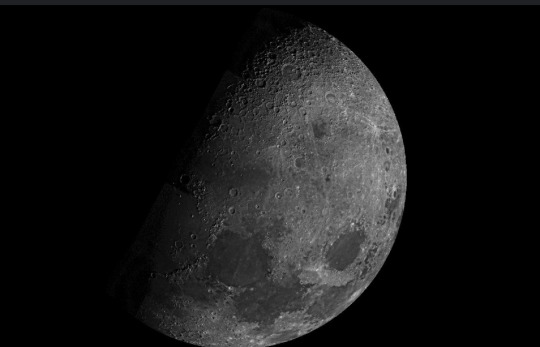
A new paper in Science Advances reviews data from the Indian Space Research Organization's Chandrayaan-1 orbiter, which discovered water ice and mapped out a variety of minerals while surveying the Moon's surface in 2008. Lead author Shuai Li of the University of Hawaii has studied that water extensively in data from Chandrayaan-1's Moon Mineralogy Mapper instrument, or M3, which was built by NASA's Jet Propulsion Laboratory in Southern California. Water interacts with rock to produce a diversity of minerals, and M3 detected spectra - or light reflected off surfaces - that revealed the Moon's poles had a very different composition than the rest of it.

Intrigued, Li homed in on these polar spectra. While the Moon's surface is littered with iron-rich rocks, he nevertheless was surprised to find a close match with the spectral signature of hematite. The mineral is a form of iron oxide, or rust, produced when iron is exposed to oxygen and water. But the Moon isn't supposed to have oxygen or liquid water, so how can it be rusting?
The mystery starts with the solar wind, a stream of charged particles that flows out from the Sun, bombarding Earth and the Moon with hydrogen.

Hydrogen makes it harder for hematite to form. It's what is known as a reducer, meaning it adds electrons to the materials it interacts with. That's the opposite of what is needed to make hematite: For iron to rust, it requires an oxidizer, which removes electrons. And while the Earth has a magnetic field shielding it from this hydrogen, the Moon does not.
"It's very puzzling," Li said. "The Moon is a terrible environment for hematite to form in." So he turned to JPL scientists Abigail Fraeman and Vivian Sun to help poke at M3's data and confirm his discovery of hematite.
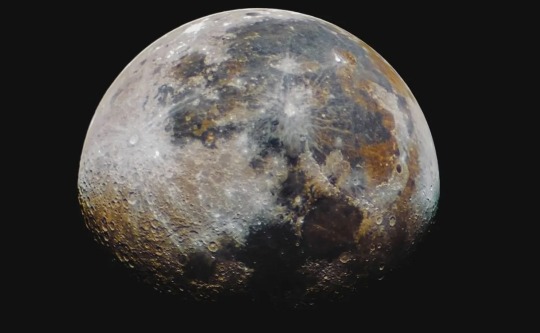
"At first, I totally didn't believe it. It shouldn't exist based on the conditions present on the Moon," Fraeman said. "But since we discovered water on the Moon, people have been speculating that there could be a greater variety of minerals than we realize if that water had reacted with rocks."
After taking a close look, Fraeman and Sun became convinced M3's data does indeed indicate the presence of hematite at the lunar poles. "In the end, the spectra were convincingly hematite-bearing, and there needed to be an explanation for why it's on the Moon," Sun said.

Their paper offers a three-pronged model to explain how rust might form in such an environment. For starters, while the Moon lacks an atmosphere, it is in fact home to trace amounts of oxygen. The source of that oxygen: our planet.
Earth's magnetic field trails behind the planet like a windsock. In 2007, Japan's Kaguya orbiter discovered that oxygen from Earth's upper atmosphere can hitch a ride on this trailing magnetotail, as it's officially known, traveling the 239,000 miles (385,00 kilometers) to the Moon.
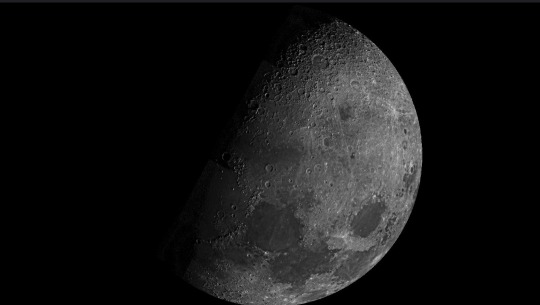
That discovery fits with data from M3, which found more hematite on the Moon's Earth-facing near side than on its far side. "This suggested that Earth's oxygen could be driving the formation of hematite," Li said. The Moon has been inching away from Earth for billions of years, so it's also possible that more oxygen hopped across this rift when the two were closer in the ancient past.

Then there's the matter of all that hydrogen being delivered by the solar wind. As a reducer, hydrogen should prevent oxidation from occurring.
But Earth's magnetotail has a mediating effect. Besides ferrying oxygen to the Moon from our home planet, it also blocks over 99% of the solar wind during certain periods of the Moon's orbit (specifically, whenever it's in the full Moon phase). That opens occasional windows during the lunar cycle when rust can form.
Originally published on NASA.gov
COMING UP!!
(Saturday, July 1st, 2023)
"WHAT IS TIME DISTORTION??"
#atmosphere#astronomy#outer space#alternate universe#astrophysics#universe#spacecraft#white universe#space#parallel universe#astrophotography#moon#rusty moon
206 notes
·
View notes
Text

The Balloon Jelly
This is the creature i mentioned in the previous post
Here is what the notes say if you cant read my admittedly bad handwriting:
Exterior sac thick for protection, Stores hydrogen.
Feeds on particles in clouds
Interior sac thin, Stores helium
Balls hold excess particles
Intakes helium to float
Helium travels through tube tward inner sac
Moves flaps for propulsion
Extra Info:
Though you cant see it, the nervous system lines the interior sac and tentacles
Color scheme for camoflauge
32 notes
·
View notes
Text
Nuclear rockets could travel to Mars in half the time − but designing the reactors that would power them isn’t easy
by Dan Kotlyar, Associate Professor of Nuclear and Radiological Engineering at Georgia Institute of Technology

NASA plans to send crewed missions to Mars over the next decade – but the 140 million-mile (225 million-kilometer) journey to the red planet could take several months to years round trip.
This relatively long transit time is a result of the use of traditional chemical rocket fuel. An alternative technology to the chemically propelled rockets the agency develops now is called nuclear thermal propulsion, which uses nuclear fission and could one day power a rocket that makes the trip in just half the time.
Nuclear fission involves harvesting the incredible amount of energy released when an atom is split by a neutron. This reaction is known as a fission reaction. Fission technology is well established in power generation and nuclear-powered submarines, and its application to drive or power a rocket could one day give NASA a faster, more powerful alternative to chemically driven rockets.
NASA and the Defense Advanced Research Projects Agency are jointly developing NTP technology. They plan to deploy and demonstrate the capabilities of a prototype system in space in 2027 – potentially making it one of the first of its kind to be built and operated by the U.S.
Nuclear thermal propulsion could also one day power maneuverable space platforms that would protect American satellites in and beyond Earth’s orbit. But the technology is still in development.
I am an associate professor of nuclear engineering at the Georgia Institute of Technology whose research group builds models and simulations to improve and optimize designs for nuclear thermal propulsion systems. My hope and passion is to assist in designing the nuclear thermal propulsion engine that will take a crewed mission to Mars.
Nuclear versus chemical propulsion
Conventional chemical propulsion systems use a chemical reaction involving a light propellant, such as hydrogen, and an oxidizer. When mixed together, these two ignite, which results in propellant exiting the nozzle very quickly to propel the rocket.

These systems do not require any sort of ignition system, so they’re reliable. But these rockets must carry oxygen with them into space, which can weigh them down. Unlike chemical propulsion systems, nuclear thermal propulsion systems rely on nuclear fission reactions to heat the propellant that is then expelled from the nozzle to create the driving force or thrust.
In many fission reactions, researchers send a neutron toward a lighter isotope of uranium, uranium-235. The uranium absorbs the neutron, creating uranium-236. The uranium-236 then splits into two fragments – the fission products – and the reaction emits some assorted particles.
youtube
More than 400 nuclear power reactors in operation around the world currently use nuclear fission technology. The majority of these nuclear power reactors in operation are light water reactors. These fission reactors use water to slow down the neutrons and to absorb and transfer heat. The water can create steam directly in the core or in a steam generator, which drives a turbine to produce electricity.
Nuclear thermal propulsion systems operate in a similar way, but they use a different nuclear fuel that has more uranium-235. They also operate at a much higher temperature, which makes them extremely powerful and compact. Nuclear thermal propulsion systems have about 10 times more power density than a traditional light water reactor.
Nuclear propulsion could have a leg up on chemical propulsion for a few reasons.
Nuclear propulsion would expel propellant from the engine’s nozzle very quickly, generating high thrust. This high thrust allows the rocket to accelerate faster.
These systems also have a high specific impulse. Specific impulse measures how efficiently the propellant is used to generate thrust. Nuclear thermal propulsion systems have roughly twice the specific impulse of chemical rockets, which means they could cut the travel time by a factor of 2.
Nuclear thermal propulsion history
For decades, the U.S. government has funded the development of nuclear thermal propulsion technology. Between 1955 and 1973, programs at NASA, General Electric and Argonne National Laboratories produced and ground-tested 20 nuclear thermal propulsion engines.
But these pre-1973 designs relied on highly enriched uranium fuel. This fuel is no longer used because of its proliferation dangers, or dangers that have to do with the spread of nuclear material and technology.
The Global Threat Reduction Initiative, launched by the Department of Energy and National Nuclear Security Administration, aims to convert many of the research reactors employing highly enriched uranium fuel to high-assay, low-enriched uranium, or HALEU, fuel.
High-assay, low- enriched uranium fuel has less material capable of undergoing a fission reaction, compared with highly enriched uranium fuel. So, the rockets needs to have more HALEU fuel loaded on, which makes the engine heavier. To solve this issue, researchers are looking into special materials that would use fuel more efficiently in these reactors.
NASA and the DARPA’s Demonstration Rocket for Agile Cislunar Operations, or DRACO, program intends to use this high-assay, low-enriched uranium fuel in its nuclear thermal propulsion engine. The program plans to launch its rocket in 2027.
As part of the DRACO program, the aerospace company Lockheed Martin has partnered with BWX Technologies to develop the reactor and fuel designs.
The nuclear thermal propulsion engines in development by these groups will need to comply with specific performance and safety standards. They’ll need to have a core that can operate for the duration of the mission and perform the necessary maneuvers for a fast trip to Mars.
Ideally, the engine should be able to produce high specific impulse, while also satisfying the high thrust and low engine mass requirements.
Ongoing research
Before engineers can design an engine that satisfies all these standards, they need to start with models and simulations. These models help researchers, such as those in my group, understand how the engine would handle starting up and shutting down. These are operations that require quick, massive temperature and pressure changes.
The nuclear thermal propulsion engine will differ from all existing fission power systems, so engineers will need to build software tools that work with this new engine.
My group designs and analyzes nuclear thermal propulsion reactors using models. We model these complex reactor systems to see how things such as temperature changes may affect the reactor and the rocket’s safety. But simulating these effects can take a lot of expensive computing power.
We’ve been working to develop new computational tools that model how these reactors act while they’re starting up and operated without using as much computing power.
My colleagues and I hope this research can one day help develop models that could autonomously control the rocket.
#science#space#futuristic#science news#NASA#DARPA#nuclear fission#space exploration#Mars#nuclear power#nuclear energy#Youtube
19 notes
·
View notes
Text
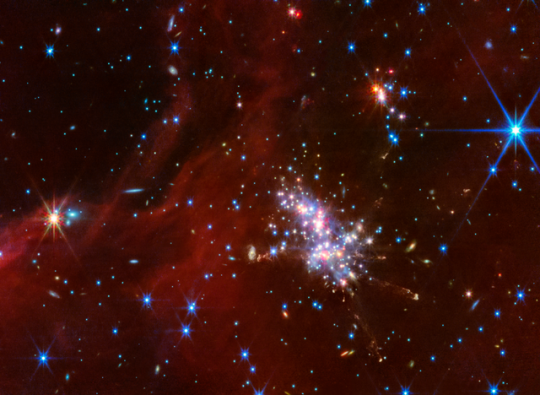
NASA’s Webb Peers into the Extreme Outer Galaxy
Astronomers have directed NASA’s James Webb Space Telescope to examine the outskirts of our Milky Way galaxy. Scientists call this region the Extreme Outer Galaxy due to its location more than 58,000 light-years away from the Galactic Center. (For comparison, Earth is approximately 26,000 light-years from the center.)
A team of scientists used Webb’s NIRCam (Near-Infrared Camera) and MIRI (Mid-Infrared Instrument) to image select regions within two molecular clouds known as Digel Clouds 1 and 2. With its high degree of sensitivity and sharp resolution, the Webb data resolved these areas, which are hosts to star clusters
undergoing bursts of star formation
, in unprecedented detail. Details of this data include components of the clusters such as very young (Class 0) protostars, outflows and jets, and distinctive nebular structures.
These Webb observations, which came from telescope time allocated to Mike Ressler of NASA’s Jet Propulsion Laboratory in Southern California, are enabling scientists to study star formation in the outer Milky Way in the same depth of detail as observations of star formation in our own solar neighborhood.
“In the past, we knew about these star forming regions but were not able to delve into their properties,” said Natsuko Izumi of Gifu University and the National Astronomical Observatory of Japan, lead author of the study. “The Webb data builds upon what we have incrementally gathered over the years from prior observations with different telescopes and observatories. We can get very powerful and impressive images of these clouds with Webb. In the case of Digel Cloud 2, I did not expect to see such active star formation and spectacular jets.”
Stars in the Making
Although the Digel Clouds are within our galaxy, they are relatively poor in elements heavier than hydrogen and helium. This composition makes them similar to dwarf galaxies
and our own Milky Way in its early history. Therefore, the team took the opportunity to use Webb to capture the activity occurring in four clusters of young stars within Digel Clouds 1 and 2: 1A, 1B, 2N, and 2S.
For Cloud 2S, Webb captured the main cluster containing young, newly formed stars. This dense area is quite active as several stars are emitting extended jets of material along their poles. Additionally, while scientists previously suspected a sub-cluster might be present within the cloud, Webb’s imaging capabilities confirmed its existence for the first time.
“We know from studying other nearby star-forming regions that as stars form during their early life phase, they start emitting jets of material at their poles,” said Ressler, second author of the study and principal investigator of the observing program. “What was fascinating and astounding to me from the Webb data is that there are multiple jets shooting out in all different directions from this cluster of stars. It’s a little bit like a firecracker, where you see things shooting this way and that.”
The Saga of Stars
The Webb imagery skims the surface of the Extreme Outer Galaxy and the Digel Clouds, and is just a starting point for the team. They intend to revisit this outpost in the Milky Way to find answers to a variety of current mysteries, including the relative abundance of stars of various masses within Extreme Outer Galaxy star clusters. This measurement can help astronomers understand how a particular environment can influence different types of stars during their formation.
“I’m interested in continuing to study how star formation is occurring in these regions. By combining data from different observatories and telescopes, we can examine each stage in the evolution process,” said Izumi. “We also plan to investigate circumstellar disks
within the Extreme Outer Galaxy. We still don’t know why their lifetimes are shorter than in star-forming regions much closer to us. And of course, I’d like to understand the kinematics of the jets we detected in Cloud 2S.”
Though the story of star formation is complex and some chapters are still shrouded in mystery, Webb is gathering clues and helping astronomers unravel this intricate tale.
These findings have been published in the Astronomical Journal
IMAGE: Scientists used NASA’s James Webb Space Telescope to examine select star-forming areas in the Extreme Outer Galaxy in near- and mid-infrared light. Within this star-forming region, known as Digel Cloud 2S, the telescope observed young, newly formed stars and their extended jets of material. This Webb image also shows a dense sea of background galaxies and red nebulous structures within the region. In this image, colors were assigned to different filters from Webb’s MIRI and NIRCam: red (F1280W, F770W, F444W), green (F356W, F200W), and blue (F150W; F115W). Credit NASA, ESA, CSA, STScI, M. Ressler (JPL)
13 notes
·
View notes
Note
HIII! I’ve been obsessing over your starships, they are truly staggeringly beautiful. I must know your style guide, or references! I am building my own artistic background and your stylized design is so… pointy and Victorian and shit. I MUST know! How does it WORK!
Tunguska is a giant root vegetable covered in ship hull texture. It's a cone because that's what physics says the optimal warship is. The radiators were supposed to explicitly evoke the masts, wires and ropes you'd find on ships.
Navikea is more of a mix of trains and tractors. There's no armor so it's all naked function - big boxy cargo bay, ring habitat, giant hydrogen cisterns (physics says you need them) and then just the propulsion part.
Both of them have radiators and engines based on real proposals.
It helps to reference everything but the thing you wanted to make. So, if you want to draw a spaceship, have references that aren't other artists' spaceships. Or even real spaceships.
16 notes
·
View notes
Text
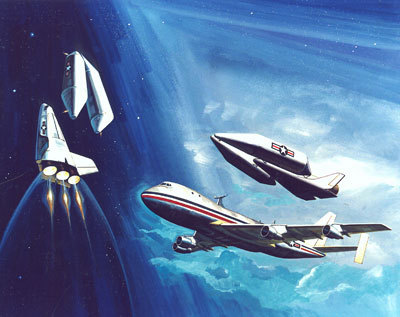
"Rockwell concept for an air-launched spaceplane produced as part of the Advanced Military Spaceflight Capability study."
"In December 1980, Don Hart of the Air Force Rocket Propulsion Laboratory at Edwards Air Force Base wrote a memo describing a proposed Air Force Space Sortie Vehicle that would be launched from the back of a 747. Ehrlich says that he knew Hart at the time, and that it is possible that Hart got the idea of the Space Sortie Vehicle concept from some work that Rockwell was then engaged in. “I’m not sure which came first, Don’s or ours, or they may even have been shared concepts,” Ehrlich remembers. He said that around 1978 or ’79 the Air Force was interested in a concept that they then called 'On-Demand Launch.' Rockwell learned of the Air Force interest and began working on several concepts. In 1979, the Air Force initiated an Advanced Military Spaceflight Capability Technology Identification Study (known as AMSC) and Rockwell was ready for it. The AMSC study actually preceded and ran concurrently with the Air Force Space Sortie Vehicle outlined in Hart’s December 1980 memo.
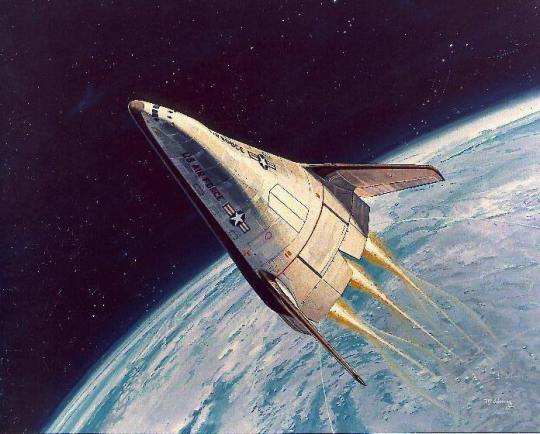
Ehrlich had taken his lifting body knowledge with him to Rockwell. The FDL-5A shape seen pulled out of the C-5 in the artist impression is the more angular version, with the single tail. But when Rockwell started working on the AMSC, they considered a spacecraft with drop tanks and mounted above a 747. The shape they used in that study was the more rounded version, with winglets. 'Different mission, different shape, but retaining the critical aerodynamic features which were key,' Ehrlich explained. The craft could be wider because it did not have to fit inside an aircraft. The Rockwell craft also had three rocket engines in its tail.
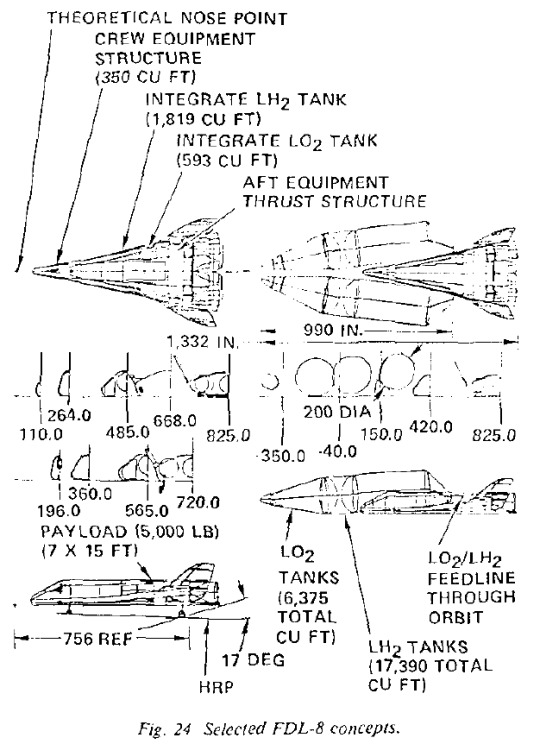
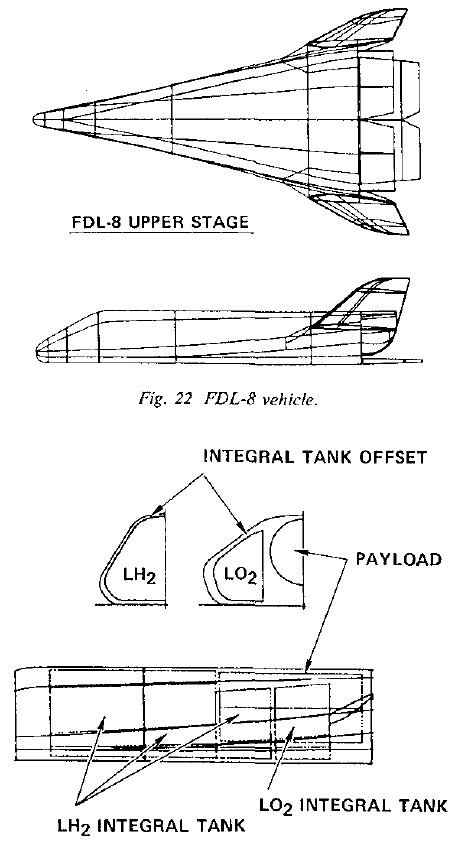
The Rockwell approach was to use the V-shaped drop tank only for hydrogen. The spacecraft itself would carry both oxygen and a little bit of hydrogen for the final push into orbit. This simplified the tank design, and since the tank was the expendable part of the spacecraft that reduced cost.
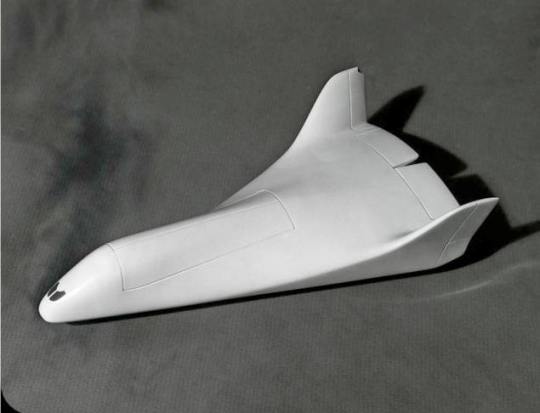
But Rockwell ran into the same limitations experienced by other companies that looked into the Sortie Vehicle Concept. Such a craft could only carry a relatively small payload. But it also required drop tanks, and that increased the expense. The Air Force wanted a cheaper vehicle and the only way to achieve that would be to develop one that was fully reusable."
Date: late 1970s/early 1980s
source
#FDL-5A#FDL-8A#Advanced Military Spaceflight Capability study#Space Sortie Vehicle#Boeing 747#747#carrier#cancelled#concept art#1970s#1980s
32 notes
·
View notes